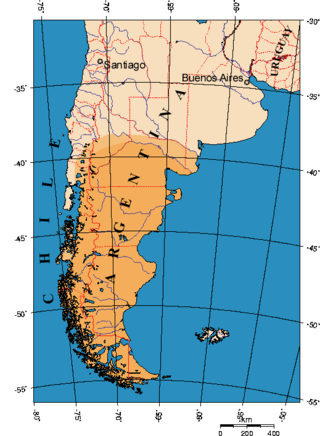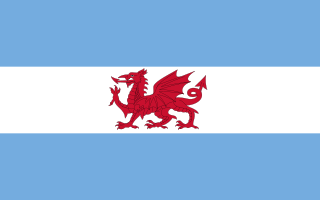
Patagonia is a geographical region that encompasses the southern end of South America, governed by Argentina and Chile. The region comprises the southern section of the Andes Mountains with lakes, fjords, temperate rainforests, and glaciers in the west and deserts, tablelands, and steppes to the east. Patagonia is bounded by the Pacific Ocean on the west, the Atlantic Ocean to the east, and many bodies of water that connect them, such as the Strait of Magellan, the Beagle Channel, and the Drake Passage to the south.

Y Wladfa, also occasionally Y Wladychfa Gymreig, refers to the establishment of settlements by Welsh colonists and immigrants in the Argentine Patagonia, beginning in 1865, mainly along the coast of the lower Chubut Valley. In 1881, the area became part of the Chubut National Territory of Argentina which, in 1955, became Chubut Province.

Río Negro is a province of Argentina, located in northern Patagonia. Neighboring provinces are from the south clockwise Chubut, Neuquén, Mendoza, La Pampa and Buenos Aires. To the east lies the Atlantic Ocean.

Neuquén is a province of Argentina, located in the west of the country, at the northern end of Patagonia. It borders Mendoza Province to the north, Rio Negro Province to the southeast, and Chile to the west. It also meets La Pampa Province at its northeast corner.

San Carlos de Bariloche, usually known as Bariloche, is a city in the province of Río Negro, Argentina, situated in the foothills of the Andes on the southern shores of Nahuel Huapi Lake. It is located within the Nahuel Huapi National Park. After development of extensive public works and Alpine-styled architecture, the city emerged in the 1930s and 1940s as a major tourism centre with skiing, trekking and mountaineering facilities. In addition, it has numerous restaurants, cafés, and chocolate shops. The city had a permanent population of 108,205 according to the 2010 census. According to the latest statistics from 2015, the population is around 122,700, and a projection for 2020 estimates 135,704.

Trevelin is a town in the western part of the Patagonian Argentine province of Chubut. The town lies on the eastern banks of the Percy River. It is located in the department of Futaleufú, 22 kilometres (14 mi) south of Esquel, and had 6,395 inhabitants at the time of the 2001 census [INDEC] and 7,908 inhabitants in the 2010 census [INDEC].

Francisco Pascasio Moreno was a prominent explorer and academic in Argentina, where he is usually referred to as Perito Moreno. Perito Moreno has been credited as one of the most influential figures in the Argentine incorporation of large parts of Patagonia and its subsequent development.

Nahuel Huapi Lake is an Andean lake in the lake region of northern Patagonia between the provinces of Río Negro and Neuquén, in Argentina. The lake has a northwest-southeast elongated shape and complex geography with several branches, peninsulas and islands. The city of Bariloche is on the southern shore of the lake and the town of Villa La Angostura lies on its northwestern shores. The lake is wholly inside Nahuel Huapi National Park. It is one of the largest lakes in northern Patagonia. It is drained by Limay River and it is part of the watershed of Negro River which discharges into the South Atlantic.

Nahuelito is a lake monster purported to live in Nahuel Huapi Lake, Patagonia, Argentina. Like Nessie, the Loch Ness Monster, the Argentine creature is named after the lake it supposedly resides in and has been described as a giant serpent or a huge hump, as well as a plesiosaur. Nahuelito has been allegedly shown through photos showing a hump, or a serpentine body.

The Tehuelche people, also called the Aónikenk, are an indigenous people from eastern Patagonia in South America. In the 18th and 19th centuries the Tehuelche were influenced by Mapuche people, and many adopted a horseriding lifestyle. Once a nomadic people, the lands of the Tehuelche were colonized in the 19th century by Argentina and Chile, gradually disrupting their traditional economies. The establishment of large sheep farming estates in Patagonia was particularly detrimental to the Tehuelche. Contact with outsiders also brought in infectious diseases ushering deadly epidemics among Tehuelche tribes. Most existing members of the group currently reside in cities and towns of Argentine Patagonia.

The La Plata Museum is a natural history museum in La Plata, Argentina. It is part of the Facultad de Ciencias Naturales y Museo of the National University of La Plata.
The Poya were a subgroup of indigenous Tehuelche people living in the Andes of Llanquihue and Palena Province as well as on the southern shores of Nahuel Huapi Lake in present-day Argentina. The Jesuit priest Nicolás Mascardi divided the Poya language into two linguistically distinct groups: the one spoken by the "comarcanos" of Nahuelhuapi and another one spoken further east as far away as the Atlantic Ocean.

The Francisco P. Moreno Museum of Patagonia is a natural history and cultural anthropology museum located in the Civic Center of Bariloche, Argentina.

Nahuel Huapi National Park is the oldest national park in Argentina, established in 1922 as Parque Nacional de Sud and reconfiguered in 1934. It surrounds Nahuel Huapi Lake in the foothills of the Patagonian Andes. The largest of the national parks in the region, it has an area of 7,050 km2 (2,720 sq mi), or nearly 2 million acres. Its landscapes represent the north Patagonian Andean Zone consisting of three types, namely, the Altoandino, the Andino-Patagónico and the Patagonian steppe. It also represents small parts of the Valdivian Rainforest.

Nicolás Mascardi was a Ligurian Jesuit priest and missionary in South America in the 17th century. He arrived to Chile in 1651. While active in Araucanía he gained notoriety for the exorcisms he practised among the Mapuches.
Santiago Roth was a Swiss Argentine paleontologist and academic known for his fossil collections and Patagonian expeditions.

Emilio Enrique Frey was a Swiss Argentine geographer.

Ramón Lista was an Argentinian soldier and explorer. He was the second governor of the Territorio Nacional de Santa Cruz, precursor of Santa Cruz Province, Argentina. He played a key role in the Selk'nam genocide in Tierra del Fuego. Later he identified with the indigenous people of Patagonia, and went to live with them until he was recalled to Buenos Aires. Lista wrote a number of books on the people and places he had found.

The last glacial period and its associated glaciation is known in southern Chile as the Llanquihue glaciation. Its type area lies west of Llanquihue Lake where various drifts or end moraine systems belonging to the last glacial period have been identified. The glaciation is the last episode of existence of the Patagonian Ice Sheet. Around Nahuel Huapi Lake the equivalent glaciation is known as the Nahuel Huapi Drift.

















